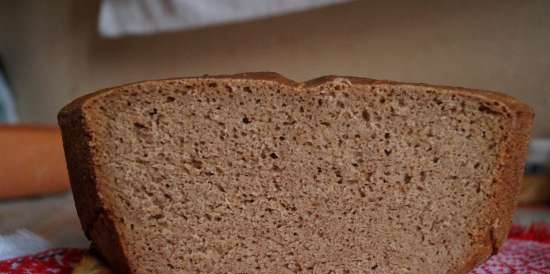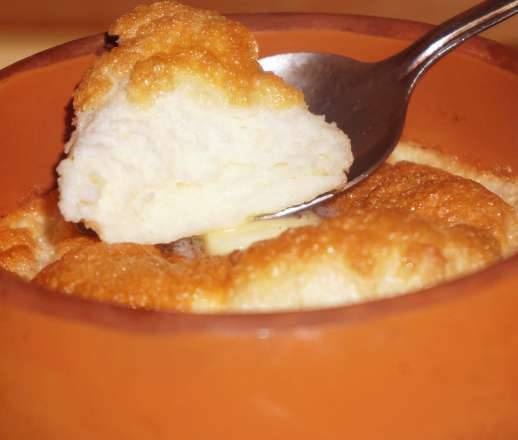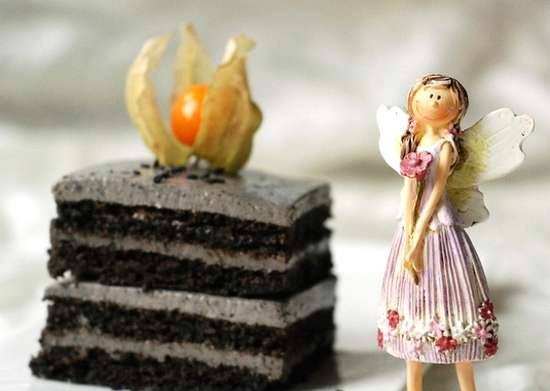Good day! Here we will discuss the real Old Slavonic rye bread, the classic one that gave our ancestors good health and longevity! which I wish you too.

Well, the recipe itself!
Based on this recipe, you will be able to cook your own, completely unique bread, and if you wish, changing something every time: combining different types of flour - today we will put barley, tomorrow buckwheat, the day after tomorrow spelled; using a brew on white or red malt; adding seeds, nuts, spices, dried fruits, dry aromatic herbs, molasses, honey, butter butt ... The scope for creativity in making sourdough bread is not limited! But let us remember that the word "bread" itself traditionally referred to bread baked according to the simplest recipe - sour rye.
We proceed from the assumption that we already have a working rye sourdough. If not, see the link below in this thread.
Bread dough is usually made with dough.
OPARA
WHAT DO YOU NEED
(assuming that you get bread weighing about 1000-1100g):
- water (not soft, not chlorinated, room temperature): 400 ml
- sourdough - 4 tablespoons
- whole grain rye flour - about 1.5 cups; whole wheat flour - about 0.5 cups. The mixture should have the consistency of thick sour cream. The amount of flour may vary slightly, since all flours have different moisture capacities.
- bowl, spoon or whisk, sieve, towel, room thermometer
WHAT TO DO
Then everything is very simple. Pour water, add sourdough, mix; sift the flour and add it to the bowl, you can also add the bran (because their enzymes and microflora can be useful to us), mix everything. Then we cover with a cloth (towel, gauze - the main thing, something breathable) and put in a warm (not hot) place overnight.
But what is it "for the night"? Usually it is 12-16 hours. At a temperature of 23-25 degrees and the proportion of sourdough from the volume of water is about 1/5. All these 3 components - proving time, the proportion of leaven in the dough, the proving temperature - can change if we have not managed to get what we need from the leaven. And we need it to rise, stay at the peak and go down (and if you are a real fan of well-fermented bread, like me, then it should stand for an hour or a few more - but the bread will be sour). The dough should eventually become well-loosened - filled with bubbles, rather or even sharply sour, more liquid. If she does not have time to become such in the allotted time, then you need to give her more time, either increase the temperature by placing it in a warmer place, or increase the proportion of the leaven. If, on the contrary, the sourdough is too sour, and the same bread is obtained on it, something needs to be reduced - put in a cooler place, or put less sourdough, or not let it stand for so long after the dough has fallen off. If you cannot influence some factor (for example, it is too hot in summer), you need to actively influence the other two.
Kneading and doughing
I draw your attention - we bake tin bread, not a hearth: for a hearth, the consistency should be noticeably thicker, and the proving time is longer, and it needs tricks when baking, so we should talk about the hearth separately. So, for tin bread weighing about 1000-1100 g, it will be required (and in general, each baker will experimentally select the best ratios for himself):
WHAT DO YOU NEED:
- dough (all)
- sunflower oil - 3 tbsp.spoons (you can do without it, or put the same amount of other vegetable oil to taste (only not linseed oil - it cannot be heated), or 3-4 tablespoons of melted butter or ghee); those who are embarrassed by the likelihood of the appearance of harmful substances when exposed to high temperatures of butter may not add it (traditionally, fats were not added to bread, unlike pastries), or use ghee.
- salt - 1.5 teaspoons with a slide - dissolve in about 50-100 ml of water and add to the dough in dissolved form;
- if desired, honey 2 tablespoons - also diluted in 50-100 ml of warm water;
- if desired, honey 2 tablespoons - also diluted in 50-100 ml of warm water; those who are embarrassed by the likelihood of the appearance of harmful substances when heating honey can use a different sweetener, or not sweeten the bread at all (traditionally, bread, again, was not sweetened; it was generally prepared only from flour and water, often even without ... salt)
- flour, preferably whole grain, but here it is no longer necessary (although you should think seven times before using premium flour) to the consistency of soft plasticine (for FORMED bread!). You should focus on the consistency, and not on the number in grams, since the real amount depends on the type and grade of flour. For reference, I will say that it takes me about 500-600g of rye flour and 100-150g of wheat flour.
- water to grease the top crust of the bread, a drop of oil (I use olive oil) to grease the mold
- bowl, spoon, sieve, mold, towel
WHAT TO DO
The dough on our sourdough turned out to be correct: the bubbles of carbon dioxide are visible throughout the volume, and judging by the rim of the dough just below the edge of the dough bowl, the dough also rose overnight (but even if this does not happen, you should not get upset - the main thing is that the bread rises; but if the bread does not loosen, it does not rise, then something is wrong somewhere - either in the leaven or in the dough).
Add diluted salt, honey, oil to it (all at room temperature, of course).
We sift the flour through a sieve - and what to do with the bran, everyone decides for himself. Bran is a controversial product, primarily because of phytic acid (a substance that binds various trace elements in the intestine - iron, magnesium, calcium, zinc - and prevents their absorption, which leads to mineral starvation and a large number of related problems). So it is not at all necessary to add all the bran to the dough (and I must say, in the old days they did not do it - on the contrary, they diligently sifted the flour, which even went into the saying "There would have been flour and a sieve, I would have been full myself"), it is quite possible, following tradition, to remove them.
We mix the dough: when it is no longer possible to stir it with a spoon, knead it with your hands - it will be very sticky (rye). When the dough reaches the consistency of VERY soft plasticine, we stop and leave it in this state for 15 minutes. In the case of rye dough, it is necessary for its moisture-absorbing flour to absorb as much water as it can, and we were not mistaken with the consistency of the dough and did not find it by the end of the batch that all the water has gone somewhere and the dough is mixed too thickly. In the case of wheat dough, this is necessary so that the gluten framework relaxes, straightens, and restores its integrity. You can still prepare the form, grease it with oil.
After 15 minutes, we continue - we add flour and mix with our hands, and the dough will remain sticky and resemble cement. Well, this is not wheat flour, and there is little gluten in it and, accordingly, glutenin and gliadin proteins, which are responsible for the elasticity of the dough and its ability to keep its shape. It makes no sense to be zealous with rye dough and knead it for too long in the hope of developing gluten, since it, one might say, does not have gluten. (For more important information on the differences between wheat and rye dough and how to work with them correctly, you can turn to the room in a personal) When the dough reaches the consistency of just soft plasticine and already behaves like a decent bun, we shift its flat surface and wet with our hands we smooth out all the irregularities - both from above, and on the sides, and below. We carefully put the bread into a mold, and put the mold in a very warm place (for example, on a battery) for 2-2.5 hours.
During this time, it should double in volume and let us know that it has reached a peak and is about to decline.It is important to catch this moment, because if the dough is too old, it can become excessively sour (although the taste and color ...), and its crust will be flat (since it has already begun to decline). And if you stop proving earlier, the dough will not loosen up - and this is still half the trouble, and most importantly, it will not TURN OUT.
And if you stop proving earlier, the dough will not loosen up - and this is still half the trouble, and most importantly, it will not TURN OUT, which means that the very real and really healthy bread will not work.
BAKING
WHAT TO DO
So, we put the future bread in a greased form, gave it a distance of 2-2.5 hours, and happily stated that it had increased by 2 times. Then you can decorate it somehow - what your fantasy will tell you.
And the oven is already on and warming up! Because at the time of planting (bread in the oven :) its temperature should be maximum.
Speaking about the temperature regime, one should immediately make a reservation that all ovens are very different, the thermometer in them indicates the temperature only roughly (besides, the temperature also depends on what gas is used), therefore each baker empirically finds his own regime. The main thing is to understand the general meaning - the mode in the oven should simulate the gradual cooling of the oven, so we gradually lower the temperature from the maximum to about 180 degrees. Usually bread is baked like this:
- put in the most preheated oven: about 250-300 degrees.
- the temperature should be immediately lowered to 200 degrees - it will decrease gradually and reach this value in about half an hour.
- lower the temperature to a minimum - up to 170-180 degrees, and in this mode bake the bread for about 45 minutes more.
- after a total of 1 hour 15 minutes - an hour and a half from the moment of planting, I turn off the oven and leave the bread there for another 10 minutes - and the oven gradually cools down completely.
It is very desirable, if not necessary, to first create conditions of high humidity in the oven - to bake "with steam". This is useful both so that the crust is not tough, and so that it cracks less (more moisture - more elasticity of the rapidly drying top layer of dough), and so that it is more ruddy (in dry conditions, the bread can turn out pale).
A common problem is too thick and hard crusts. The top crust can be protected with a lid or foil to create a dome effect, and can also be steamed as mentioned above. If the side and bottom crusts harden, this indicates that the bread has been baked for too long, or at too high a temperature, or in a dish that is too thin, or both. In general, it was baked in such conditions when too much moisture came out of it. If, with hard crusts, the crumb is not baked, it means that the heat or thin walls are to blame; if baked, it means that the bread was baked for a long time, or it was baked for a long time and it was hot, or all together ... In general, it is important (and not easy) to find such a baking mode so that the crumb is baked, but the crust does not harden either. The solution to this problem is greatly facilitated by the use of a thick-walled form and baking at moderate temperatures, but for enough time to reach readiness.
LET'S TRY! IS IT POSSIBLE?
And now our bread has been baked - it is beautiful, ruddy, and has a wonderful smell, but it is not time to eat it yet! In it, fermentation has not yet completely ended, so it will be hard on the stomach, and the liquid has not evaporated yet, so the hot crumb will resemble rubber. By all the rules, you need to wrap the bread in a linen towel, or better in two, put it so that the air circulates and moisture evaporates from all sides - for example, on top of the form across it - and wait until morning. Yes, yes, the whole night! Here is morning bread, completely cooled, with completed fermentation, with formed crumb - this is the very REAL Bread to which we have been going for so long! Speaking from the point of view of bakery technologies, bread is good if the crumb is evenly baked, evenly loosened, when pressed with a finger, it straightens, the crust is thin and crispy.We check it all - and try! The bread is moderately sour, moderately salty and sweetish, with an indescribable rich taste, aromatic and lively. Here it is - a miracle born in a field under the sun's rays and in a house under skillful and kind hands, for the joy and health of all household members !!
The basic recipe for leavened bread (sponge method) is the basis for your bread creation:
🔗












